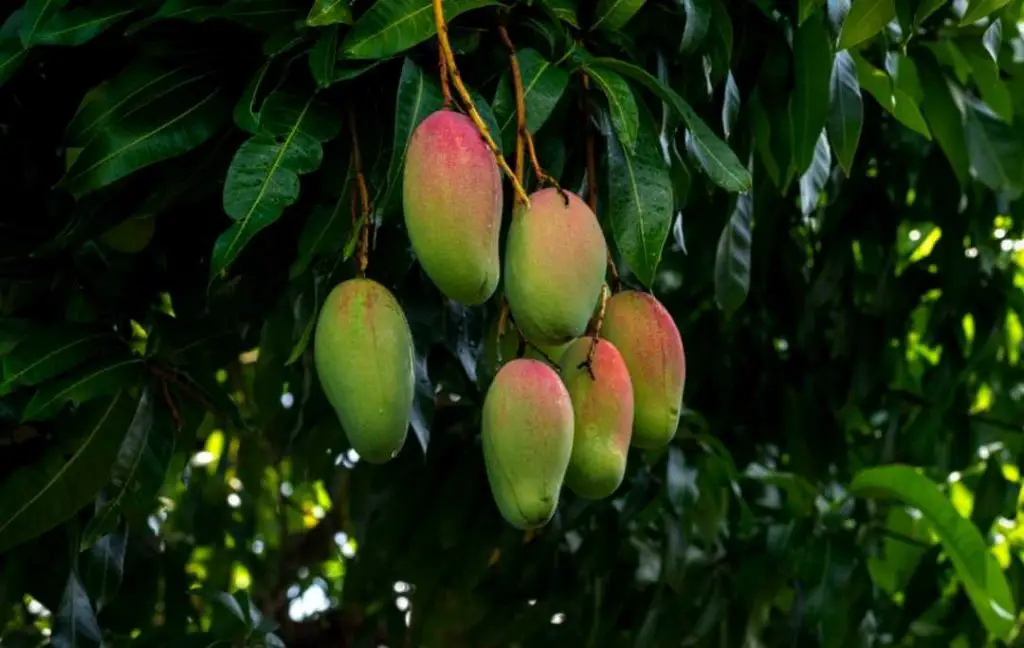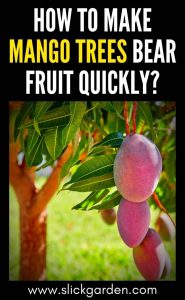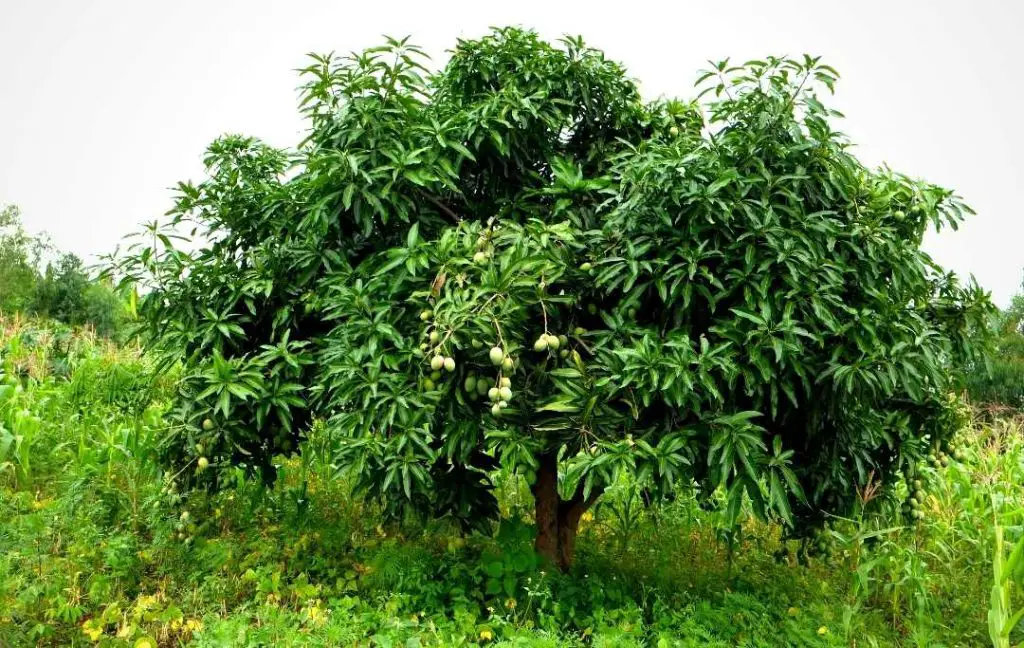Mango is an evergreen tree and belongs to the family of Anacardiaceae. This tree has a thick trunk and the leaves are shiny and dark green. The flowers of the tree have cream-pink petals.
The mango fruit has an oval shape with soft yellow flesh. The color of the skin of the fruit is found in yellow, green, and even red color. The height of the tree can be 45 meters.
If you grow mango trees in your garden, you will get fruit and shade in your garden on hot summer days. A healthy mango tree in a suitable climate and location can produce juicy mangoes per year.

Some varieties bear fruit every year and some in alternate years. If the age of the mango tree is about 10 years it may produce fruit in alternate years. But sometimes it happens that your mango tree stops producing enough fruit or does not give you any fruit.
The problem is that their fruiting cycle is disturbed. If you are facing such problems, you should have to take some steps to figure out the basic problem and try to solve it. There are many reasons for not fruiting your mango tree.
THE REASONS WHICH ARE RESPONSIBLE FOR NOT PRODUCING FRUIT ON YOUR MANGO TREE
Many factors are the reason for not producing fruit. Now we will discuss all the reasons one by one. Carefully examine your mango tree and see which factor is responsible.
1- INCREASE SUN EXPOSURE
Fruit trees want full sun exposure for producing juicy fruit. You should choose a sunny location for growing mango trees because it will also become a reason for not fruiting. It is also an important factor for healthy growth to bear fruit.
- 6 hours of sunlight is very important for your mango tree.
- If the trees which are grown in the neighbors of the mango tree shadowing the mango tree then they will become the reason for not reaching sunlight. In that case, you should prune down these neighboring trees.
2- SUITABLE TEMPERATURE
Keep in mind that mangoes only produce fruit in a frost-free environment. If you live in a cold climate and want to try your mango trees outside in your garden, you will not get your favorite juicy fruit.
The temperature should not be below 4.5-degree centigrade or 40 Fahrenheit. Because this temperature will damage the blossoms of the mango tree.
If your mango tree is very small then you can protect it by covering it with a blanket. You can also use heat lamps for Christmas lights to protect the mango tree from the cold.
3- WATERING
Your mango tree doesn’t need much water over 4 years of age. If you are living in a hot climate then you can water your mango tree. Overwatering can become the reason for limiting fruit production and it also affects the quality of the fruit.
- Too much rain also becomes the reason for dropping the premature fruit and it will become the reason for lowering your yield.
- In winter, if you water too much then it will affect the formation of looms of the mango tree.
4- DISEASES AND PESTS
Anthracnose and powdery mildew are two basic fungus diseases that are responsible for a non-fruiting mango tree. If the foliage of the mango tree remains wet for a long long time then these diseases will occur.
ANTHRACNOSE
Anthracnose is a disease that creates black spots on the leaves. The bloom will turn into blight and at last, the fruit of the tree will rot. You will get a few fruits with black spots.
POWDERY MILDEW
It is another disease that can stop the fruiting of your mango tree. The symptoms of this disease are very clear when you see the blossoms and leaves of the mango tree are covered with a powdery fungus.
It means your tree is affected by this disease. If the infection is very severe then the flower panicles are destroyed. In that case, your tree can’t produce fruit.
CURE
These diseases can be controlled only by using the spray with a sulfur or copper fungicide solution. You should use the spray when the blooms start to form until fruits are ready to be harvested.
PESTS
If the infection in the mango tree is caused by pests then you can control the population of the pests with the use of regular neem spray.
5- FERTILIZATION
Overfertilization or wrong fertilization is also an important factor for the non-fruiting of the mango tree. If you are using a large amount of nitrogen, it will result in the growth of foliage only, not flowers.
If you plant your mango tree in the lawn then the fertilizer which you are using in the lawn has a high amount of nitrogen which will affect the fruiting power of your mango tree.
- The roots of the mango tree spread beyond the drip line of the tree and they start feeding on the nitrogen from the soil. In that situation, you should add some bone meal to the soil around the base of your mango tree. This will help to negate the effect of too much fertilizer in the soil.
- You should use a fertilizer that has a high content of potassium. It is suitable for citrus trees in your garden.
- Over-fertilizing is also another reason for non-fruiting. So you should read all the instructions and information on the packet of fertilizer. These instructions are very helpful, you should use the right amount of fertilizer according to the needs of your plants.
6- SEVERE PRUNING
Pruning keeps the plant in shape but severe pruning may reduce the production. You should prune only those items which are broken, diseased or dead.
- Pruning encourages the new growth of the plant. But if you do the pruning at the wrong time then it may remove the tips that produce blossoms.
- And one more thing you can prune a mango tree immediately after fruiting but not before fruiting.
7- AGE OF THE MANGO TREE
It is also a very important reason for not bearing fruit on your mango tree. If your tree is very young or too old it will not produce fruit for you. After 10 years of age,e mango trees start bearing fruit only in alternate years. A mango tree that has no flowers can’t produce fruit.

Read More
- GROWING WATERMELON IN GROW BAGS
- HOW TO GROW SWEET CORN IN CONTAINERS?
- EVERYTHING YOU NEED TO KNOW ABOUT GROWING PEAR TREE FROM SEEDS
IF YOUR MANGO TREE DOES NOT PRODUCE FRUIT THEN YOU SHOULD FOLLOW THE FOLLOWING TIPS
Most people grow mango trees to get juicy fruit at home. They hope to get fresh fruit but a non-fruiting mango tree is not their goal. You can use different techniques for getting healthy fruit from your mango trees. These techniques help to induce the flowers.
Hope the following methods will help you to force a mango tree to fruit.
HOW TO ENCOURAGE YOUR MANGO TREE TO PRODUCE FRUIT?

The unfavorable conditions will give stress to your mango tree to produce fruit. Here we are going to tell you some ways through which you can give stress to the plant. The stress which you can give to your mango tree is of the following types.
1- Salting the ground
The salt tolerance mechanism is very helpful to stress the mango tree. You can apply salt around the mango tree.
2- Drought stress
If you want to improve the floral induction then withholding water for 2-3 months will enter the tree into a dormant phase. You should apply water stress after immediately the maturation of the first summer shoot flush. This will increase the percentage of flowers and consequently increase fruit production.
3- Slashing the trunk
You can chop the bark of the trunk or branches to prevent the food from reaching the upper part of the mango tree. You should be careful during this and should not cut so deep.
4- Smoking the tree
Smoke has ethylene and the branches of the tree that got the most smoke eventually produce the most fruit. Smoking also helps to drive away insects and pests. Smoke can induce early flowering but smoking should be done after the rainy season.
5- Pruning half the blooms
In case the tree is blooming you can prune half blooms.
6- Using compost
Compost and mulch both will help you to increase the level of nutrients in the soil. If the mango tree gets enough organic material then definitely the production of the tree will be increased up to 24%.
CHEMICAL FORCING OF BLOOMS ON MANGO TREE
If you want to stimulate your mango tree to produce fruit then you can use chemical treatment for this purpose. But keep in mind, if you want to force your mango tree for blooming or fruiting by chemical methods then apply these techniques on a healthy tree that is 10 years old.
- Potassium nitrate can be used to induce the mango tree to produce flowers. You can use this method on shoots that are between 4.5 and 8.5 months old. Within 7 days you will see the flowers will start emerging after the treatment. From this method, you can double the fruit production of your mango tree.
- Prepare a solution of 2% of potassium nitrate and water. Dissolve 20 grams of potassium nitrate in 1 liter of water and prepare a solution for spraying your mango tree. This will force your tree to produce flowers. You can spray both sides of the leaf branches and trunk. If there is no response of the first spray then you can apply the solution the second time, after the first application of 15 to 20 days. If your plant is producing flowers then never use nitrate because it can damage your mango blossoms. The application of the solution should be made before the emergence of the flowers.
- You can also use calcium nitrate solution instead of potassium nitrate for good results.
- You can also use paclobutrazol In the soil. After 8 weeks, you can use a spray of potassium nitrate to increase the number of blooms on the mango tree.
- In sunny weather or on mature trees, you should cut the concentration of nitrate in half.
- Always apply the spray on the mango tree on a cloudy day.
- First, you should check the weather forecast. If rain is expected then you should avoid using the chemical solution on those days.
